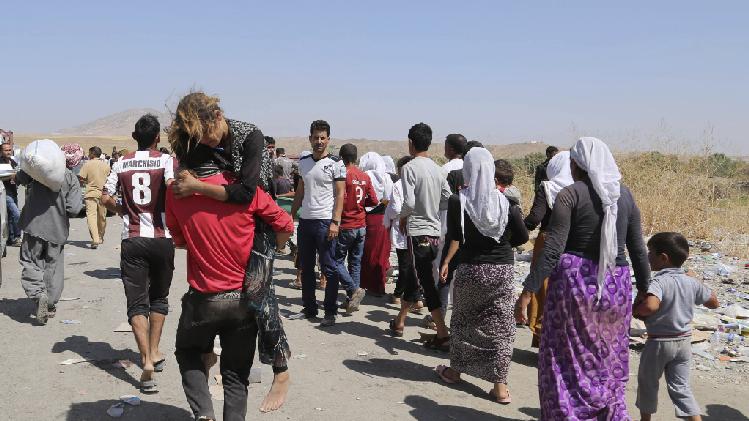
On July 17, 2014 the world witnessed the newest chapter in aerial terrorism. This was not an airliner that exploded over a city or slammed into a building; it was was an attack on a 298 passenger commercial airline en route from Amsterdam to Malaysia that claimed the lives of all the men, women, and children on board. It crashed in Torez, a small Ukrainian city. As a result, the escalating situation in Ukraine suddenlybecame even more dire. The international community scrambled to determine what happened as the world watched, stunned and, mortified, by the tragedy that affected every corner of the globe.As the world watches, questions must be raised about the capability of other groups—namely the Islamic State of Iraq and Syria (ISIS) and Boko Haram.
The international community now knows that the plane did not merely fall out of the sky, but was shot down by Pro-Russian Separatist’s forces in Ukraine with what appears to be a Soviet-era SA-11 missile. This surface-to-air missile, also known as the “Gadfly,” was likely launched from a Buk-M1 missile system. With its 18-mile range, the SA-11 had the capability of hitting a target at the 33,000-foot altitude MH17 was. Ukrainian intelligence claims that the launch took place in Snizshne, a rebel controlled town, confirming U.S. intelligence reports that the launch took place inside war-torn Ukraine. A post on the social media site Vkontakte,by Separatist leader Igor Streklov claimed to have shot down a military transport plane, but it was quicklyremoved after confirmation that the cargo plane was, instead, a civilian plane.. It is likely that the passenger plane was hit by mistake, yet another unfortunate, disturbing outcome of what has escalated from the Crimean crisis. A few days before Sreklov, a former Russian Intelligence Officer and buddy of President Vladimir Putin, made this claim a Ukrainian cargo plane was shot down by separatist forces with what seems to be a military operated anti-aircraft weapon. Separatists have also taken down at least a dozen aircraft that include Ukrainian fighter jets and convoy planes, since the fighting began. In any case, these missile strikes require either training or expertise from someone who can operate a complex system. If this coincidence was not shocking enough, news footage and ground reports seem to show the Buk transport system heading back to Russia (image here). That’s right Russia: the most notorious, vodka drinking, separatist-backing baddies there are. This has provided the international community with a plethora of questions surrounding Russia’s true action in Ukraine.
In all honesty, this development should come as no surprise. United States EUROCOM General Phillip Breedlove confirmed what many already knew to be true—the Russians have been backing the separatists since the Crimean crisis began. Lately, demonstrations have escalated, and Russia has been trafficking anti-aircraft machinery and conducting military training exercises on the eastern border. President Putin, of course, refutes this accusation. The Russian news agency, ITAR-TASS reported that separatists had taken a Buk under their control. While the picture reported by news agencies is not the highest quality, it is clear that two missiles are missing. This seems to imply, Russian separatists in Ukraine wanted toeither return or make it look like they were returning the missile systems they borrowed from Russians. Much is up in the air, but it is becoming more and more clear that Moscow is behind the supply of the Buk-M1, and U.S. intelligence is currently building a strong case against Russia to prove just that. Reports on Wednesday confirm that rocket launchers and other weapons have continued to funnel into Russia, less than a week after MH17 was shot down. The entire situation is reminiscent of the United States backed Mujahideen during the 1988 Soviet invasion of Afghanistan in which the United States provided advanced weapons, specialized training, and financial assistance to the opposition forces. The Mujahideen leaders later became the Taliban that the United States has since spent trillions of dollars fighting.
The MH17 case has brought an important question regarding rebel groups, or “terrorists,” as Ukrainian President Petro Poroshenko called them, to light: What if others got their hands on similar missiles? Two terrorists groups would absolutely do everything in their power to have a SA-11 or Buk system: The Islamic State of Iraq and Syria (ISIS) and Boko Haram. These two groups have gained headlines in recent months for their brutality, sophistication, and ability to instill not only horrific violence, but alsounparalleled fear across their areas of operation. Each time a news orTwitter feed is updated, these two heinous groups seems to be at it again—a bomb here, an execution there—horrendous act after horrendous act. Al-Qaeda recently denounced an affiliation from ISIS after a brutal recruitment video was released that depicted atrocious killings, beheadings, and executions of unarmed soldiers. Seemingly enough, Al-Qaeda also denounced any affiliation with Boko Haram after the kidnapping of nearly 300 girls in May 2014, threatening to sell them into the sex trade. ISIS controls large portions of land along the Tigris and Euphrates rivers in Iraq and cities throughout Syria, while Boko Haram controls most ofNortheastern Nigeria.
Both organizations have a common goal: to establish an “Islamic State,” creating a caliphate in which Islamic rule, harsh Sharia law, and Western expulsion enable the government to maintain complete control over their populations. In Nigeria, Boko Haram, led by Abubakar Shekau, is responsible for nearly 23,000 deaths in a string of assassinations, bombings, and guerilla warfare.These tactics include a massacre of nearly 300 civilians on the side of a road, an unfathomable amount of bombings, and several deadly attacks on public transportation systems. ISIS, led by Abu Bakr al-Baghdadi, has conducted similar style warfare, including crucifixions of enemies, while taking over large parts of Syria and Iraq. ISIS is also in control of a former Iraqi chemical weapons facility, and allegedly has around 90 pounds of Uranium-238, which can be used in a nuclear bomb. While it is unlikely that ISIS has the expertise or resources to do so, the notion of “nuclear terrorism” remains on everyone’s mind.
After the downing of MH17, a new sense of urgency has emerged. After all, there is a huge flux of Soviet-era weapons that have been floating around the Middle East and Northern Africa for the last several decades. Legal sales of Small Arms and Light Weapons (SALW) have spread across the Dark Continent, but illegal sales have seen a rise as ethnic and intra-state conflict in Syria, Libya, the Central African Republic, the Democratic Republic of the Congo, and South Sudan intensifies. Seizures of over 6,000 Ak-47’s on their way to Boko Haram from neighboring Cameroon in January and September of 2013 are just two of many cases that illustrate the growth in illegal arms sales. The global arms trade, according to the Stimson Center, is valued at $70 billion a year, with $1 billion of that money going towards SALW. The continued fascination with the AK-47 has recently been introduced into the drug trade, increasing both the volatility and interconnectedness of these two trafficking operations. Each trade is becoming intertwined with jihadists and terrorist groups, and there is a blend of networks. In 2013, militants in an Al-Qaeda in the Islamic Maghreb (AQIM) attack on an Algerian natural gas facility primarily used weapons obtained via arms trafficking networks to overtake the facility and kill 38 people before interference by the French military.
Unfortunately, the news gets worse. After the overthrow and death of Libyan dictator Moammar Gaddafi, it was reported that only 25% of the 20,000 Man Portable Air Defense Systems (MANPADS) were re-acquired by the $40 million project that the U.S. government funded, that is 15,000 MANPADS that the United States DID NOT recover. But wait, it gets worse. It was then reported that at least 800 of these MANPADS were refurbished and shipped on over to the infamousAfrican jihadist group ready for use. These include SA-7 and SA-24 surface-to-air missiles (SAM), another Russian favorite. This was apparently reported by two CIA counterterrorism officers, but never addressed by the U.S. intelligence community. Whoops. Granted, at the time (2012) the United States was probably not aware of the monster Boko Haram would eventually become. While some missiles would have inevitably ended up on the black market, it is still disappointing that the United States was aware of their shipment to a growing terrorist group and did not attempt to interdict.
The situation is similar for the newly founded “Islamic State.” Most of their weapons have been obtained via illegal arms trafficking and “gun-running.” According to former House Representative Ron Paul (R-Texas), they have managed to get their hands on a large amount of U.S. weapons that were intended to reach the opposition forces for use against the Assad regime in Syria. According to the Washington Post, strong financial backing, theability to attract young jihadists, and a large influx of weapons have allowed ISIS to make significant gains in both Iraq and Syria in previous months. The group is estimated to have “millions of dollars” at their disposal. Even more terrifying is that ISIS has access to American military weapons. A report from Business Insider noted that 52 152mm M198 Howitzers were seized from the Iraqi military during the ISIS offensive. M198s have GPS targeting capabilities and a range of up to 20 miles. One can envision long-range attacks into Baghdad and other government held cities, as ISIS continues to advance on the capital. Aside from this small arsenal, ISIS apparently has obtained “precision guided weaponry,” including Scud missiles. Scuds have been used several times in Syria, and the Iraqi establishment seems to have obtained them as well, escalating the already dire situation. A Scud is a Soviet-era missile that can fly at five times the speed of sound and is capable of carrying conventional, as well as Weapons of Mass Destruction, or WMD (biological, nuclear, and chemical) payloads. U.S. officials argue that the Scuds are decommissioned or unusable, but if wrong, ISIS obtained a very powerful friend. U.S. officials also expound upon the possibility that ISIS could have obtained Stinger missiles, a shoulder launched surface-to-air missile, from the raided Iraqi military bases. Yet another propaganda video shows an SA-7 MANPADS being used. These missiles, undoubtedly have the capability to take down commercial planes from lower altitudes. Chinese, Russian, and U.S. anti-tank systems are also shown to be under ISIS control.
What is the actual plausibility that Boko Haram or ISIS would use MANPADS or Surface-to-Air Missiles to take down a plane? In 2002, Al-Qaeda attempted to use one to take down an Israeli commercial airliner in Kenya, luckily missing. One would hope that neither would go after a commercial passenger airliner, but based off of their brutal campaigns against civilians, these aircrafts seems like a potential choice. Bringing down an airliner in one of these countries would likely not have the same international affect because the world is focused on the quickly deteriorating relationship between Russia and the West. It should also be noted that using a MANPADS to take down a large commercial airliner would be near impossible at an altitude similar to that of MH17. The more likely way to use this weaponry would be attacking a cargo plane, much like Russian separatist forces in Ukraine. Hitting a Nigerian or Iraqi military cargo plane is likely at the top of each ruthless organization’s “Things to Destroy” list. The United States has currently suspended all of its flights through ISIS territory and parts of Africa (see map here), but not in Northern Nigeria, where Boko Haram has established control. If a missile did hit a plane, then current U.S. intelligence, surveillance, and reconnaissance (ISR) missions in the area would become much more hostile and aggressive.
Whether or not United States and other international intelligence organizations have considered this a viable threat is unknown, although one could assume they have. In any case, the notion of terrorists using shoulder-fired or ground-launched missiles, many of them Russian or American, to target commercial or military planes is utterly terrifying. It does bring in a bigger foreign question to light regarding these two terrorists’ organizations: What should the U.S. policy be? The world, after all, is looking for a leader on this issue. So far, to combat ISIS, the United States has provided weapons, as well as financial resources in Syria, and ISR and armed drones (retained under U.S. control), along with 300 U.S. troops in Iraq to help gather intelligence and provide strategic support. The armed drones are for U.S. protection, not U.S. offensive strikes. In Nigeria, similar resources—drones, money, and counterterrorism advisors—have been sent to assist in locating the 300 missing girls, thus far, to no avail. Republicans and Democrats alike have claimed that Obama’s stance is too weak and that the U.S. Intelligence Community should have seen this coming. Senator John McCain (R-Arizona) and House Representative Colleen Hanabusa (D-Hawaii) called for a stronger military response, saying the Obama administration was, “making [the strategy] up as they go.”
That being said, it is much easier to call the shots when critics are not the ones who actually make the decisions and live with the consequences they entail. Is the correct response really air strikes or a ground invasion into a region in which we just spent 10 years fighting? After trillions of dollars and thousands of men and women who will never come home, it is safe to say that the American public is sick of war for a while. It would seems that that stronger diplomatic efforts should be made to ease the tension in Iraq and that the United States should supply all the intelligence and surveillance needed in both situations. Unfortunately, with the current political tensions involving Iraqi Prime Minister Nouri al-Malaki and rival factions in Iraq, little progress will be made. On the Nigerian front, the United States should be using drone surveillance to help find the missing girls. Nigerian military sophistication cannot do it alone, and U.S. military advisors and prowess would be undoubtedly helpful. What cause is nobler than preventing teenage girls from being sold into sex slavery? A strong stance in Nigeria would be ideal to limit Boko Haram from becoming a regional problem that could spread into neighboring countries. This would not involve any risk to U.S, lives and the expanded ISR capabilities would be immensely helpful to Nigeria.
The likely response, however, is stagnation in both situations. Sure, the United States will continue to send money and help with ISR to an extent, but a hard stance is difficult to envision. We are simply too occupied at the moment. The Iranian nuclear deal which was just extended until November as well as theinvestigation of possible Russian involvement in the downing of MH17 are issues that seem more prominent to U.S. strategic interests. The world can sometimes be too large to make a strong stance on an issue, especially one seemingly as small as Boko Haram. As far as ISIS is concerned, the response is also unlikely to change. A strong case could be made that cooperation in confronting ISIS would strengthen U.S. and Iranian relations, as both have an interest in seeing them booted out of the region, but, again, too many other issues are placed ahead of it. Limited air strikes have been conducted, but the damage they have caused is questionable and fear of extended warfare looms in Congress. The United States, though, definitely has interests in seeing both of these groups defeated from a strategic and moral standpoint. In a time where crucifixions and children being sold into sex slavery is becoming the new norm, the world is in need of a strong leader. One can only hope that the past does not speak to the future and these issues are addressed before escalation makes its horrifying ascent.


